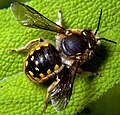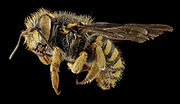Anthidium manicatum, commonly called the European wool carder bee, is a species of bee in the family Megachilidae, the leaf-cutter bees or mason bees...
27 KB (3,122 words) - 13:15, 14 September 2024
Anthidium luizae Anthidium maculifrons Anthidium maculosum Anthidium manicatum Anthidium masunariae Anthidium montanum Anthidium montivagum Anthidium mormonum...
9 KB (796 words) - 23:31, 24 October 2024
the stems and leaves, is used by some species of bees (e.g. Anthidium manicatum and Anthidium oblongatum in Megachilidae) for nest-building. Hybrids are...
10 KB (963 words) - 08:32, 11 July 2024
unmanaged bee species in the world." Like most Anthidium, rather than cutting leaves or petals, A. manicatum scrapes the hairs from leaves to use for nesting...
16 KB (1,651 words) - 12:27, 20 July 2024
baboon, common pheasant, red deer, Bengal tiger, Xylocopa sonorina, Anthidium manicatum and elk.[citation needed] Often in polygynous systems, females will...
18 KB (2,230 words) - 17:25, 18 November 2024
essential part of nest building for the European wool carder bee (Anthidium manicatum). This bee species incorporates trichomes into their nests by scraping...
25 KB (2,956 words) - 17:49, 15 October 2024
flight, and large-headed morph, incapable of flight, for males. Anthidium manicatum also displays male-biased sexual dimorphism. The selection for larger...
106 KB (12,442 words) - 00:52, 25 November 2024
officinalis. They are also widely used by the European wool carder bee (Anthidium manicatum), which scrape the hairs from the plant in order to use them for...
12 KB (1,039 words) - 17:41, 3 January 2024
known as resource defense polygyny and males of the bee species Anthidium manicatum (also known as the European wool carder bee) exhibit this behavior...
112 KB (13,880 words) - 13:15, 2 November 2024
Schmoll, G. (1992). "Phenology of two territorial solitary bees, Anthidium manicatum and A. florentinum (Hymenoptera: Megachilidae)". Journal of Zoology...
3 KB (322 words) - 13:55, 31 March 2023
Bombus ruderarius and Bombus sylvarum the European wool carder bee Anthidium manicatum, and other members of the family Megachilidae which collect plant...
501 bytes (86 words) - 13:44, 5 May 2018
example passage-like cavities in the house, which are also used by Anthidium manicatum. The brood cells are made from vegetable wool. The species populates...
7 KB (602 words) - 00:49, 18 October 2024
6 (2012): 674-684. Zavortink, Thomas J., and Sandra S. Shanks. "Anthidium manicatum (Linnaeus)(Hymenoptera: Megachilidae) in California." The Pan-Pacific...
13 KB (1,895 words) - 15:25, 20 December 2023
this species include: Anthidium codoense Ducke, 1907 Anthidium cingulatum Friese, 1909 Anthidium insignissimum Strand, 1910 Anthidium latum var asuncionanum...
1 KB (89 words) - 05:49, 22 January 2021
Pemphredon unicolor, Hylaeus confusus, Paranthidiellum lituratum and Anthidium manicatum. This species can be found in Europe and in the Near East. Biolib...
2 KB (104 words) - 11:41, 1 May 2024
Endemic Maaminga rangi Early, Masner, Naumann, Austin 2001; Endemic Anthidium manicatum (Linnaeus, 1758); Accidental Introduction Osmia coerulescens (Linnaeus...
62 KB (5,728 words) - 23:04, 22 November 2024
bartsia blunthorn bee Macropis europaea, yellow loosestrife bee Anthidium manicatum, European wool carder bee Stelis breviuscula, little dark bee Stelis...
18 KB (1,707 words) - 17:07, 14 March 2022











